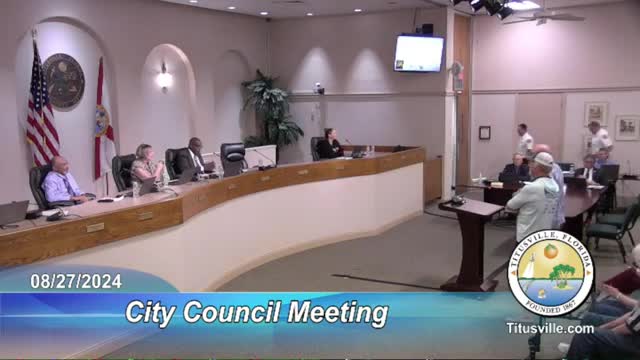Titusville tackles stormwater crisis to save Indian River Lagoon
August 28, 2024 | Titusville, Brevard County, Florida
This article was created by AI summarizing key points discussed. AI makes mistakes, so for full details and context, please refer to the video of the full meeting. Please report any errors so we can fix them. Report an error »

In a recent government meeting, officials discussed critical environmental challenges facing the Indian River Lagoon, particularly focusing on stormwater management and its impact on water quality. The dialogue highlighted the detrimental effects of nitrogen and phosphorus runoff, primarily from fertilizer use and septic systems, which contribute to the lagoon's declining health.
Captain Blair Wiggins, who leads the Indian River clam restoration project, reported significant progress, with over 45 million clams released in the past five years. He emphasized a new initiative aiming to release one billion clams, which is crucial for improving water clarity and supporting seagrass growth. Wiggins noted that while recent salinity levels have been favorable, the increasing urban development in the area poses a risk of excessive freshwater influx during storms, which could disrupt the delicate balance necessary for the survival of brackish water organisms.
Dr. Todd, a water quality expert, reinforced the importance of maintaining salinity levels in the lagoon, stating that fluctuations can stress marine life. He praised Titusville's efforts in stormwater management, citing 24 projects that have successfully removed 27,000 pounds of nitrogen annually from the watershed. Dr. Todd advocated for prioritizing wet retention systems, which hold water in place and enhance nutrient removal, thereby reducing the volume of water entering the lagoon.
The meeting also addressed the ongoing project at Max Brewer Causeway, which aims to restore the area damaged by storms. This project will include the introduction of clams and seagrasses to enhance the ecosystem while implementing wave attenuation structures to protect the shoreline.
Officials concluded the meeting by acknowledging the progress made in stormwater management and clam restoration, while stressing the need for continued efforts to address salinity issues and protect the lagoon's fragile ecosystem. The discussions underscored the interconnectedness of urban development, water quality, and environmental sustainability in the region.
Captain Blair Wiggins, who leads the Indian River clam restoration project, reported significant progress, with over 45 million clams released in the past five years. He emphasized a new initiative aiming to release one billion clams, which is crucial for improving water clarity and supporting seagrass growth. Wiggins noted that while recent salinity levels have been favorable, the increasing urban development in the area poses a risk of excessive freshwater influx during storms, which could disrupt the delicate balance necessary for the survival of brackish water organisms.
Dr. Todd, a water quality expert, reinforced the importance of maintaining salinity levels in the lagoon, stating that fluctuations can stress marine life. He praised Titusville's efforts in stormwater management, citing 24 projects that have successfully removed 27,000 pounds of nitrogen annually from the watershed. Dr. Todd advocated for prioritizing wet retention systems, which hold water in place and enhance nutrient removal, thereby reducing the volume of water entering the lagoon.
The meeting also addressed the ongoing project at Max Brewer Causeway, which aims to restore the area damaged by storms. This project will include the introduction of clams and seagrasses to enhance the ecosystem while implementing wave attenuation structures to protect the shoreline.
Officials concluded the meeting by acknowledging the progress made in stormwater management and clam restoration, while stressing the need for continued efforts to address salinity issues and protect the lagoon's fragile ecosystem. The discussions underscored the interconnectedness of urban development, water quality, and environmental sustainability in the region.
View full meeting
This article is based on a recent meeting—watch the full video and explore the complete transcript for deeper insights into the discussion.
View full meeting